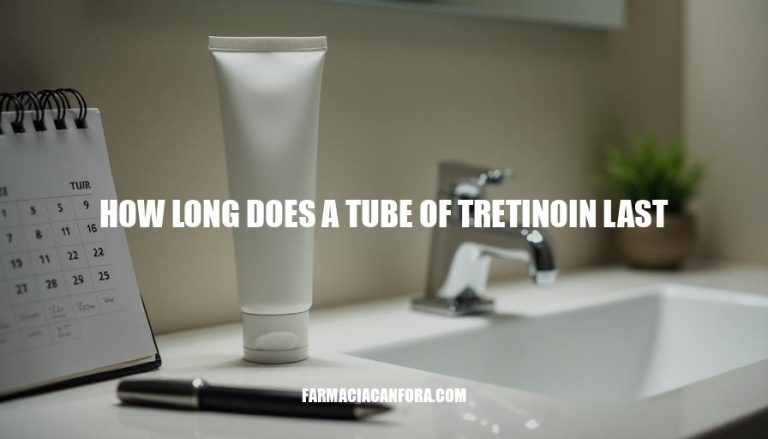


You want to know how long a tube of tretinoin lasts so you can use it effectively and make smart purchasing decisions. Tretinoin is a popular topical cream that helps with acne, skin texture, and aging. But its lifespan depends on how often you apply it and how much you use each time.
The frequency of application varies from person to person.
Some people put it on every night, while others do it less often to avoid irritation. The amount you use also matters – a small pea-sized portion or a bigger layer can make a big difference in how fast the tube runs out. Understanding these factors helps you estimate how long your product will last and plan accordingly.
The longevity of a tube of tretinoin is influenced by several factors, including tube size, concentration, and application habits. Each of these elements plays a significant role in determining how long the product lasts, and they vary widely depending on individual usage patterns.
Tretinoin tubes come in various sizes, such as 20g, 30g, and 45g. The size of the tube directly impacts its duration.
For instance:
A 20g tube typically lasts around 2-3 months if used daily with a pea-sized amount.
A 30g tube can extend to 3-4 months under similar conditions.
A 45g tube might last up to 6 months if applied every other day.
Practical Example: A person using tretinoin for spot treatment on acne might find that even a smaller tube, like 20g, lasts longer than expected because they are not applying it to the entire face. Conversely, someone using it on larger areas, such as the neck or chest, will deplete the tube faster, even if it’s a larger size.
Tretinoin is available in different concentrations, such as 0.01%, 0.025%, 0.05%, and 0.1%. Higher concentrations are more potent and often require smaller amounts per application due to their increased efficacy and potential for irritation.
Lower concentrations might necessitate slightly larger amounts to achieve desired results.
Practical Example: A beginner using 0.025% tretinoin might apply a pea-sized amount every other night to allow their skin to adjust, making a 30g tube last up to 5 months. On the other hand, an experienced user applying 0.1% tretinoin nightly might use the same tube in just 3 months.
The frequency and method of application significantly affect how long a tube lasts. Dermatologists often recommend using a pea-sized amount for the entire face, but individual habits can vary:
Daily Use: A 20g tube might last 2-3 months.
Every Other Day Use: Extends the duration to 4-6 months.
Spot Treatment: Can make even a small tube last for over 6 months.
Practical Example: A user applying tretinoin to their face and neck nightly will go through a tube faster than someone using it exclusively for spot treatment on acne.
Additionally, those who use more than the recommended pea-sized amount might find themselves reordering more frequently.
Other considerations include storage conditions and skin type. Proper storage in a cool, dry place ensures the product remains effective, while skin type influences absorption and the amount needed.
Practical Example: A person with oily skin might use a gel formulation that spreads more easily, requiring less product per application, whereas someone with dry skin might use a cream that necessitates a slightly larger amount.
Understanding these factors can help users plan their purchases and optimize their skincare routines. Each individual’s experience with tretinoin is unique, shaped by their specific needs and habits.
1tretinoin-creams.com2tretinoin-creams.com3hersimplebeauty.com4lifepathdoc.com5miiskin.com
A tube of tretinoin lasts anywhere from 2-6 months, depending on several factors including tube size, concentration, and individual application habits. Understanding these elements can help users plan their purchases and optimize their skincare routines.
Tube size plays a significant role in determining the longevity of the product. A 20g tube typically lasts around 2-3 months if used daily with a pea-sized amount, while a 30g tube can extend to 3-4 months under similar conditions. A 45g tube might last up to 6 months if applied every other day.
Concentration also affects the duration of the product. Higher concentrations are more potent and often require smaller amounts per application due to their increased efficacy and potential for irritation. Lower concentrations might necessitate slightly larger amounts to achieve desired results.
Application habits significantly impact how long a tube lasts. Daily use typically lasts 2-3 months, while every other day use extends the duration to 4-6 months. Spot treatment can make even a small tube last for over 6 months.
Other considerations include storage conditions and skin type. Proper storage in a cool, dry place ensures the product remains effective, while skin type influences absorption and the amount needed.
By being aware of these factors and adopting efficient application techniques, users can make their tubes last longer and get the most out of their skincare routine.